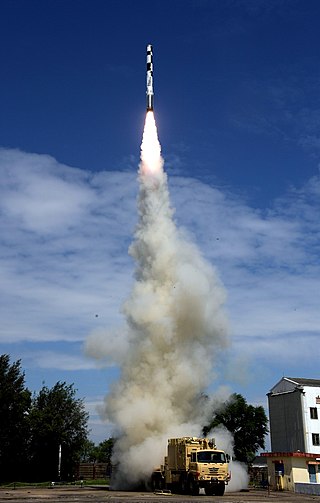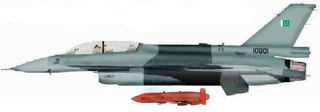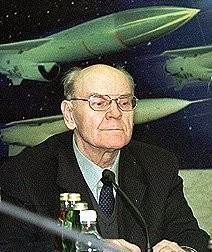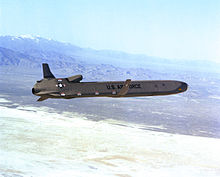
A cruise missile is a guided missile used against terrestrial or naval targets, that remains in the atmosphere and flies the major portion of its flight path at an approximately constant speed. Cruise missiles are designed to deliver a large warhead over long distances with high precision. Modern cruise missiles are capable of traveling at high subsonic, supersonic, or hypersonic speeds, are self-navigating, and are able to fly on a non-ballistic, extremely low-altitude trajectory.

The Storm Shadow is a Franco-British low-observable, long-range air-launched cruise missile developed since 1994 by Matra and British Aerospace, and now manufactured by MBDA. "Storm Shadow" is the weapon's British name; in France it is called SCALP-EG. The missile is based on the French-developed Apache anti-runway cruise missile, but differs in that it carries a unitary warhead instead of cluster munitions.

A submarine-launched cruise missile (SLCM) is a cruise missile that is launched from a submarine. Current versions are typically standoff weapons known as land-attack cruise missiles (LACMs), which are used to attack predetermined land targets with conventional or nuclear payloads. Anti-ship cruise missiles (ASCMs) are also used, and some submarine-launched cruise missiles have variants for both functions.

An air-to-surface missile (ASM) or air-to-ground missile (AGM) is a missile designed to be launched from military aircraft at targets on land or sea. There are also unpowered guided glide bombs not considered missiles. The two most common propulsion systems for air-to-surface missiles are rocket motors, usually with shorter range, and slower, longer-range jet engines. Some Soviet-designed air-to-surface missiles are powered by ramjets, giving them both long range and high speed.

The BrahMos is a medium-range ramjet supersonic cruise missile that can be Launched from Submarines, Ships, Fighter Aircraft or TEL. It is a joint-venture between the Indian Defence Research and Development Organisation (DRDO) and the Russian Federation's NPO Mashinostroyeniya, who together have formed BrahMos Aerospace. The missile is based on P-800 Oniks. The name BrahMos is a portmanteau formed from the names of two rivers, the Brahmaputra of India and the Moskva of Russia.

The Popeye is a family of air-to-surface missiles developed and in use by Israel, of which several types have been developed for Israeli and export users. A long-range submarine-launched cruise missile variant of the Popeye Turbo has been speculated as being employed in Israel's submarine-based nuclear forces. The United States operated the Popeye under a different designation according to US naming conventions as the AGM-142 Have Nap.
Terrain contour matching, or TERCOM, is a navigation system used primarily by cruise missiles. It uses a contour map of the terrain that is compared with measurements made during flight by an on-board radar altimeter. A TERCOM system considerably increases the accuracy of a missile compared with inertial navigation systems (INS). The increased accuracy allows a TERCOM-equipped missile to fly closer to obstacles and at generally lower altitudes, making it harder to detect by ground radar.
Standoff weapons are missiles or bombs which may be launched from a distance sufficient to allow attacking personnel to evade the effect of the weapon or defensive fire from the target area. Typically, they are used against land- and sea-based targets in an offensive operation. The name is derived from their ability to engage the target while standing off outside the range at which the defenders are likely to engage the attacker. Typical stand-off weapons include cruise missiles, glide bombs and short-range ballistic missiles.

A nuclear triad is a three-pronged military force structure of land-based intercontinental ballistic missiles (ICBMs), submarine-launched ballistic missiles (SLBMs), and strategic bombers with nuclear bombs and missiles. Countries build nuclear triads to eliminate an enemy's ability to destroy a nation's nuclear forces in a first-strike attack, which preserves their own ability to launch a second strike and therefore increases their nuclear deterrence.

The BrahMos Aerospace is an Indo-Russian multinational aerospace and defense corporation, with core manufacturing concentrations in Cruise missiles. Headquartered in New Delhi, India, it was founded as a joint venture between the India's Defence Research and Development Organisation and NPO Mashinostroyenia of Russia. Company's name is a portmanteau formed from the names of two rivers, the Brahmaputra of India and the Moskva of Russia.

The Ra'ad, is a subsonic, standoff, and an air-launched cruise missile (ALCM) designed and jointly developed by the National Engineering & Scientific Commission (NESCOM) and Pakistan Air Force's Air Weapons Complex.
The FC/ASW, FMAN/FMC, FOSW or SPEAR 5 is a next generation missile programme launched by France and the United Kingdom in 2017 to succeed their jointly-developed Storm Shadow/SCALP as well as their respective Exocet and Harpoon anti-ship missiles. Equally funded by both countries, the project is led by European missile manufacturer MBDA and is a product of the close defence relationship set out between both nations by the Lancaster House treaties. In June 2023, it was announced Italy would join the programme and began providing funding in November.

GerbertAleksandrovich Yefremov is a Soviet and Russian scientist, design engineer and Professor of Technical Sciences.
BrahMos-II or BrahMos-2 or BrahMos Mark II is a hypersonic cruise missile currently under joint development by India's Defence Research and Development Organisation and Russia's NPO Mashinostroyenia, which have together formed BrahMos Aerospace Private Limited. It is the second of the BrahMos series of cruise missiles. The BrahMos-II is expected to have a range of 1,500 kilometres and a speed of Mach 8. During the cruise stage of flight the missile will be propelled by a scramjet airbreathing jet engine. Other details, including production cost and physical dimensions of the missile, are yet to be published.
The Ra'ad-II is a standoff and an air-launched cruise missile (ALCM) derived from the Hatf-VIII Ra'ad. It was first publicly unveiled on the Pakistan Day Parade on 23 March 2017,
The 3M22Tsirkon also spelled as 3M22 Zircon is a scramjet-powered, thermonuclear-capable hypersonic cruise missile produced by Russia for the Russian Navy, with launch platforms on frigates and submarines. The missile has a reported top speed of Mach 9. The weapon was first used during Russian invasion of Ukraine.

A hypersonic weapon is a weapon capable of travelling at hypersonic speed, defined as between 5 and 25 times the speed of sound or about 1 to 5 miles per second.











